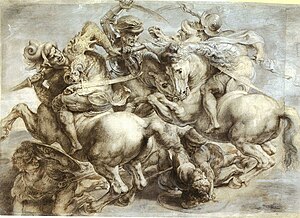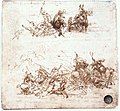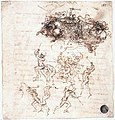art.wikisort.org - Painting
The Battle of Anghiari (1505) was a planned painting by Leonardo da Vinci in the Salone dei Cinquecento (Hall of the Five Hundred) in the Palazzo Vecchio, Florence. Its central scene would have depicted four men riding raging war horses engaged in a battle for possession of a standard at the Battle of Anghiari in 1440.

Many preparatory studies by Leonardo still exist. The composition of the central section is best known through a drawing by Peter Paul Rubens in the Louvre, Paris. This work, dating from 1603 and known as The Battle of the Standard, was based on an engraving of 1553 by Lorenzo Zacchia, which was taken from the painting itself or possibly derived from a cartoon by Leonardo. Rubens succeeded in portraying the fury, the intense emotions and the sense of power that were presumably present in the original painting. Similarities have been noted between this Battle of Anghiari and the Hippopotamus Hunt painted by Rubens in 1616.
In March 2012, a team led by Maurizio Seracini announced that they had found evidence that the painting still exists on a hidden inner wall behind a cavity, underneath a section of Giorgio Vasari's fresco in the chamber.[1] The search was discontinued in September 2012, without any further progress having been made, due to conflict among the involved parties.[2] In October 2020, a group of art historians concluded that work had never been executed.
History


In 1504 Leonardo da Vinci was given the commission by gonfaloniere Piero Soderini, a contract signed by Niccolò Machiavelli, to decorate the Palazzo Vecchio's Salone dei Cinquecento (Hall of the Five Hundred). At the same time his rival Michelangelo, who had just finished his David, was designated the opposite wall. This was the only time that Leonardo da Vinci and Michelangelo worked together on the same project. The painting of Michelangelo depicted an episode from the Battle of Cascina, when a group of bathing soldiers was surprised by the enemy. However Michelangelo did not stay in Florence long enough to complete the project. He was able to finish his cartoon, but only began the painting. He was invited back to Rome in 1505 by the newly appointed Pope Julius II and was commissioned to build the Pope's tomb.
Leonardo da Vinci drew his large cartoon in the Basilica of Santa Maria Novella, on the east wall, depicting a scene from the life of Niccolò Piccinino, a condottiere in the service of duke Filippo Maria Visconti of Milan. He drew a scene of a violent clash of horses and a furious battle of men fighting for the flag in the Battle of Anghiari. Giorgio Vasari in his book Lives of the Most Excellent Painters, Sculptors, and Architects praised the magisterial way in which Leonardo had put this scene on paper:
It would be impossible to express the inventiveness of Leonardo's design for the soldiers' uniforms, which he sketched in all their variety, or the crests of the helmets and other ornaments, not to mention the incredible skill he demonstrated in the shape and features of the horses, which Leonardo, better than any other master, created with their boldness, muscles and graceful beauty.

Leonardo built an ingenious scaffold in the Hall of Five Hundred that could be raised or folded in the manner of an accordion. This painting was to be his largest and most substantial work. Since he had a bad experience with fresco painting (The Last Supper; refectory of Santa Maria delle Grazie, Milan), he wanted to apply oil colours on the wall. He began also to experiment with such a thick undercoat (possibly mingled with wax), that after he applied the colours, the paint began to drip. Trying to dry the painting in a hurry and save whatever he could, he hung large charcoal braziers close to the painting. Only the lower part could be saved in an intact state; the upper part couldn't dry fast enough and the colours intermingled. Leonardo then abandoned the project.[citation needed]
Michelangelo's and Leonardo's unfinished paintings adorned the same room together for almost a decade (1505–1512). The cartoon of Michelangelo's painting was cut in pieces by Bartolommeo Bandinelli out of jealousy in 1512. The centerpiece of The Battle of Anghiari was greatly admired and numerous copies were made for decades.[citation needed]
Reconstruction of room
This section does not cite any sources. (March 2020) |
During the mid-16th century (1555–1572), the hall was enlarged and restructured by Vasari and his helpers on the instructions of Cosimo I, in order that the Duke could hold court in this important chamber of the palace. In the course of the renovations, the remnants of famous (but unfinished) artworks from the previous plan of decoration for the hall, were lost; including The Battle of Cascina by Michelangelo and The Battle of Anghiari by Leonardo da Vinci.
Vasari himself painted new frescoes on the now-extended walls. On the walls are large and expansive frescoes that depict battles and military victories by Florence over Pisa and Siena :
- The Taking of Siena
- The Conquest of Porto Ercole
- The Victory of Cosimo I at Marciano in Val di Chiana
- Defeat of the Pisans at the Tower of San Vincenzo
- Maximillian of Austria Attempts the Conquest of Leghorn
- Pisa Attacked by the Florentine Troops
Possible rediscovery

Maurizio Seracini, an Italian expert in high-technology art analysis, believes that Leonardo's Anghiari is hidden behind Vasari's Battle of Marciano in Val di Chiana (1572).[3] In the upper part of Vasari's fresco, 12 meters above the ground, a Florentine soldier waves a green flag with the words "Cerca trova" ('He who seeks, finds').[3] These enigmatic words are suggested to be a hint from Vasari, who had praised The Battle of Anghiari highly in his writings, incomplete and damaged as it was. Seracini believes it is unlikely that Vasari would have willingly destroyed Leonardo's work. Vasari's concealment and preservation of another painting, Masaccio's Holy Trinity, during a subsequent renovation project also assigned to him by Cosimo I, is cited as precedent. Using non-invasive techniques, such as a high-frequency, surface-penetrating radar and a thermographic camera, Seracini made a survey of the hall. Among other findings, he discovered that Vasari had built a curtain wall in front of the original east wall, and painted his fresco on the new wall. Seracini believes the original fresco of Leonardo da Vinci to be located on the older wall, beneath it. Sensors found a gap of 1 to 3 centimeters between the two walls, large enough for the older fresco to be preserved.[4]

In early 2007, the city council of Florence and the Italian Minister of Culture approved further investigation. After unsuccessful attempts to fund the development of a more advanced non-invasive scanning system, in December 2011 Seracini and his associates drilled small holes through areas of the Vasari fresco believed to have been previously damaged and restored, hence no longer comprising "original paint" from Vasari's work. An endoscopic probe with a camera was extended into the cavity behind the curtain wall, and the team discovered fragments of pigment and indications of fresco surfacing on the plaster of the inner wall; samples were taken at the time, with the results being announced publicly on 12 March 2012. Seracini believes that this is conclusive evidence for the continued existence of Leonardo's fresco. Seracini's research is highly controversial with strong criticism being levelled against him for drilling the holes.[5] In March 2012 researchers said "the material found behind the Vasari wall shows a chemical composition similar to black pigment found in brown glazes on Leonardo's Mona Lisa and St. John the Baptist, identified in a recently published scientific paper by the Louvre, which analyzed all the da Vinci paintings in its collection."[6] In mid-2012, efforts to investigate the cavity behind Vasari's fresco were discontinued, due to the conflicting views of interested parties, as to whether and how to proceed.[2][4]
Alfonso Musci and Alessandro Savorelli published an article in the journal of the Italian Institute of Renaissance Studies at Palazzo Strozzi in December 2012, disputing Seracini's interpretation of the motto on the green flag in Vasari's mural. In the article they attempted to investigate the writing “CERCA TROVA” in the context of the real events that occurred during the Battle of Scannagallo (1554) and made known through the works of Bernardo Segni, Antonio Ramirez de Montalvo, Domenico Moreni. These works contain detailed descriptions of anti-Medicean heraldic insignia present in Marciano della Chiana, including eight green flags embroidered with the verse of Dante: "Libertà va cercando, ch'è sì cara, ch'è sì cara come sa chi per lei vita rifiuta" (Purgatorio , vv. 70–72) and the ancient coat of arms "Libertas" in golden. These banners had been delivered by Henry II of France to the troops of the Florentine exiles, armed by the Republican banker Bindo Altoviti and led by Piero Strozzi and Giambattista Altoviti. After the defeat of the Republicans and of the French troops, these green flags would have become spoils of the winners, and handed over to Grand Duke Cosimo I. They would have been publicly displayed in the central nave of the Basilica of San Lorenzo. Following the theme of luck and damnation of the oldest Florentine 'stemma' (Libertas) in the cycle of paintings conceived by Cosimo I and Vincenzo Borghini in the Salone dei Cinquecento, Musci and Savorelli suggest that the motto "CERCA TROVA" was an allusion to the verse of Dante and to the fate of the Republicans ("searching freedom and finding death"), and thereby dispute Seracini's interpretation of the green flag as a hint left by Vasari.
In October 2020, a group of art historians concluded that the painting had never been executed on the basis that Leonardo failed to invent a technique for it, which would have included a layer of gesso and oil. Seracini has not accepted their conclusions.[7]
- Study of battles on Horseback and foot by Leonardo
- Study of battles on Horseback and foot by Leonardo {apparent sketch for Battle of The Standard at top right}
- Group of riders in the Battle of Anghiari by Leonardo
References
- Kington, Tom (12 March 2012). "Art historians say they have found evidence of hidden Leonardo da Vinci". The Guardian. London.
- Lorenzi, Rosella (22 September 2012). "Search for Mysterious Lost Da Vinci Aborted". Discovery News. London. archived copy
- Musci, Alfonso (2011), A Musci A Savorelli Giorgio Vasari cerca trova. La storia dietro il dipinto (in Italian), p. 238
- Farmer, Brit McCandless (26 May 2019). "From the Archives: Looking for the Lost Leonardo". 60 Minutes. CBS News. Retrieved 28 May 2019.
- "Data Support Theory on Location of Lost Leonardo da Vinci Painting". National Geographic Society. 12 March 2012. Retrieved 12 March 2012.
- Kington, Tom (6 December 2011). "Lost Leonardo Da- Vinci battle scene sparks row between art historians". The Guardian. London. Retrieved 12 March 2012.
- Greenberger, Alex (13 October 2020). "Leonardo's 'Lost Masterpiece' Can't Be Found Because It Was Never Painted, Experts Claim". ARTnews. Retrieved 9 May 2022.
Further reading
- Newton, H. Travers; Spencer, John R. (March 1982). "On the Location of Leonardo's Battle of Anghiari". The Art Bulletin. 64 (1): 45. doi:10.2307/3050192. JSTOR 3050192.
- Tierney, John (5 October 2009). "A High-Tech Hunt for Lost Art". The New York Times. Retrieved 25 March 2020.
- Looking for Leonardo, With Camera in Hand, The New York Times, 26 August 2011
- M. Pieraccini, D. Mecatti, G. Luzi, M. Seracini, G. Pinelli and C. Atzeni, Non-contact intrawall penetrating radar for Heritage survey: the search of the Battle of Anghiari by Leonardo da Vinci, NDT&E international, Vol. 38, pp. 151–157 (2005)
- Vasari, Giorgio. ""Cerca trova". La storia dietro il dipinto. Con un'Appendice di Alessandro Savorelli, "Rinascimento", LI, Firenze (Olschki), MMXI". Il Rinascimento: 237–268. ISSN 0080-3073.
- Vasari, Giorgio: Lives of the Painters, Sculptors and Architects, Volumes I and II. Everyman's Library, 1996. ISBN 0-679-45101-3
External links
- The Battle of Anghiari – description of its creation
- The Battle of Anghiari – museum website
- "The Battle of Anghiari" by Leonardo da Vinci and Peter Paul Rubens
- DaVinci decoded
- 'Lost Da Vinci' prompts art row, BBC News, 6 December 2011.
На других языках
[de] Schlacht von Anghiari (Leonardo da Vinci)
Die Schlacht von Anghiari (1505) ist ein verschollenes Gemälde von Leonardo da Vinci, das sich an der Stelle eines späteren Freskos von Giorgio Vasari im Salone dei Cinquecento des Palazzo Vecchio in Florenz befunden haben soll. Thema des Gemäldes ist eine Szene aus der Schlacht von Anghiari von 1440, in der das Heer von Florenz mit Unterstützung des Kirchenstaates und der Republik Venedig eine überlegene Streitmacht des Herzogtums Mailand geschlagen hat.- [en] The Battle of Anghiari (Leonardo)
[es] La batalla de Anghiari (Leonardo)
La batalla de Anghiari (en italiano, La battaglia di Anghiari) es una pintura al fresco de Leonardo da Vinci, actualmente perdida, pintada en un muro del Salón de los Quinientos del Palazzo Vecchio de Florencia entre 1503 y 1506. Consta que en su ejecución Leonardo contó con la ayuda de un pintor al que los documentos llaman «Ferrando Spagnuolo, dipintore», que pudiera ser Fernando Yáñez de la Almedina o quizá Fernando Llanos. Leonardo abandonó Florencia en 1506, dejando la pintura inacabada. En 1549 aún estaba a la vista, pero desapareció en 1563 como muy tarde, al encomendarse a Giorgio Vasari la remodelación decorativa del gran salón. Recientemente algún experto ha afirmado haber hallado con ayuda de un endoscopio, el antiguo fresco disimulado tras un muro debajo de los frescos de Vasari.[fr] La Bataille d'Anghiari
La Bataille d'Anghiari est une peinture murale peinte par Léonard de Vinci de 1504 à 1506 sur le mur Est de la salle du Grand Conseil (appelée aujourd'hui salle des Cinq-Cents) du Palazzo Vecchio de Florence. Léonard de Vinci quitta Florence en 1506, laissant l'œuvre inachevée. Pour la plupart des commentateurs, Léonard avait utilisé pour ce travail un procédé nouveau, à l'encaustique, et son travail ne se conserva pas, bien que les artistes aient admiré ses cartons, encore visibles au début du XVIIe siècle. Son pendant, la Bataille de Cascina de Michel-Ange, resta également inachevé. En 1563, Vasari, chargé de la rénovation du Palazzo Vecchio, peignit de nouvelles scènes de bataille sur les murs de la salle des Cinq-Cents.[it] Battaglia di Anghiari (Leonardo)
La Battaglia di Anghiari era una pittura murale di Leonardo da Vinci, databile al 1503-1504 e già commissionata per il Salone dei Cinquecento (allora detto "Sala del Gran Consiglio") di Palazzo Vecchio a Firenze. A causa dell'inadeguatezza della tecnica, il dipinto subì danni e non è certo che i suoi resti fossero stati lasciati in loco, incompiuti e mutili; circa sessant'anni dopo, la decorazione del salone venne rifatta da Giorgio Vasari; non si conosce se all'epoca fossero ancora presenti i frammenti leonardiani o se l'architetto aretino li abbia distrutti. Alcuni sostengono che li abbia nascosti sotto un nuovo intonaco o una nuova parete: ricerche e 'saggi' finora condotti non hanno sciolto il mistero. Nel mese di ottobre 2020, dopo anni di ricerche, viene reso noto che probabilmente Leonardo si fermò alla delicata fase preparatoria del muro, non portata a termine per motivi tecnici, senza mai iniziare la pittura vera e propria[1].[ru] Битва при Ангиари (фреска)
«Битва при Ангиари» (итал. Battaglia di Anghiari, также иногда передается как «Битва при Ангьяри») — утраченная фреска Леонардо да Винчи. Художник работал над ней в 1503—1506 гг.Другой контент может иметь иную лицензию. Перед использованием материалов сайта WikiSort.org внимательно изучите правила лицензирования конкретных элементов наполнения сайта.
WikiSort.org - проект по пересортировке и дополнению контента Википедии


